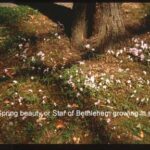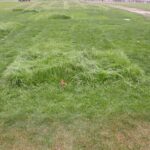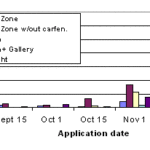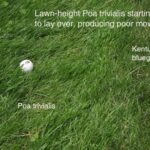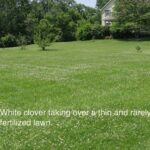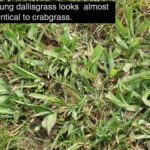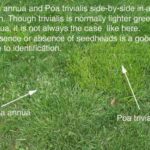Category: Weed Control
Spring Dandelion Control for Professionals
Many turf areas did not get treated for broadleaf weeds last fall because of the dry weather. Though fall applications are most effective for controlling broadleaf weeds, spring applications are warranted for new lawns or areas that did not get treated last fall. Spring applications will be most effective if you wait until dandelions are […]
Star of Bethlehem, Spring Beauty Emerging in Shaded Areas
Star of Bethlehem and Spring Beauty are currently emerging and flowering in shaded areas. Both plants have pretty white flowers with the Star of Bethlehem having six petals while Spring Beauty has only five petals . The Star of Bethlehem was once planted as an ornamental while the Spring Beauty is native. Both plants are […]
Dandelions: Friend or Foe?
The annual bloom of dandelions is already here in southern Indiana and just around the corner in the rest of the state. Though some find dandelions attractive and some may actually eat them in salads or wine, others consider dandelions as weeds and try to control them in a lawn. The optimum time to control […]
Buyer Beware: Annual Ryegrass is Not a Persistent Turfgrass Species for Indiana Homelawns
There are many cool-season turfgrasses suitable and adapted to home-lawns in Indiana. They include; Kentucky bluegrass, turf-type tall fescue, fineleaf fescue and to a certain extent even “perennial” ryegrass. Many new lawns are established using seed because it is much less expensive than sod. Unfortunately, in many instances inexperienced homeowners or landscape contractors often purchase […]
Herbicide Delays after Seeding
Almost all herbicides will affect turfgrass seedlings and application delays are usually needed following seeding. Following is information gleaned from available labels of most herbicides or herbicide types that would be used in Indiana . This is intended to provide a general idea of the limitations of each active ingredient, but please refer to the […]
Spring Weed Control or Seeding?
With last year’s late summer and fall drought, many areas are in need of reseeding. The question comes up about seeding and weed control: should the weeds be controlled first or should the seeding be done first? This seems like a simple question, but it’s fairly complex depending on the turf and weed species present […]
Timing of Preemergence Herbicides
If a preemergence herbicide is justified on a turf area, the timing of application is important. In theory, applying too early will expose the herbicide to soil microbes and processes in the soil that may break it down, allowing crabgrass to germinate during the latter part of the summer. Conversely, applying too late may miss […]
Controlling Wild Onion or Wild Garlic in Lawns
Wild onion and wild garlic emerging in the southern two-thirds of Indiana and these are difficult-to-control weeds. These weeds look very similar to the garden variety onion except the stems of the wild type are much thinner and do not grow as tall as the garden variety. The most effective method for controlling onion and […]
Controlling broadleaf weeds after the drought
Now that the lawn and weeds have greened-up from the recent rains, broadleaf herbicides should be effective yet this fall. Though these herbicides work faster when the plants are actively growing, these herbicides will still work as long as the plants are green and photosynthesizing. Therefore, applications into November will work, albeit slower. You may […]
Coping with Late Season Drought in Turf
(Adapted from the Midwest Regional Turf Foundation Factsheet, Oct 1, 2004) After an extremely wet summer, turf drought stress has come out of nowhere almost throughout the state after a dry August and September. Though September and October are prime growing months, turf will not recover unless the turf receives ample rain or irrigation soon. […]
Attempting Ground Ivy Control
I’ve received a number of calls recently on ground ivy control. Here’s a rerun on an August Turf Tip on controlling ground ivy. Background Ground ivy is difficult to control and it is a problem in 31% of lawns maintained professionally in Indiana. Earlier research by Eric Kohler has expanded our understanding of ground ivy […]
More Evidence for Effectiveness of Fall Applications of Broadleaves
It’s been fairly well established that fall applications of herbicides are more effective than spring applications for broadleaf control. Recent work in Nebraska reported that applications of 2,4-D and/or dicamba were far more effective in controlling dandelions and Canada thistle when applied 1 to 10 days after the first fall frost than when applied 5 […]
Wait to Control Broadleaf Weeds
Though many broadleaf weeds like ground ivy, clover, and plantain are currently thriving in turf areas, resist the urge to spray them now. Following is a summary of a study that we discussed at Field Day that can help professionals improve broadleaf weed control, especially difficult-to-control weeds like ground ivy. Background Ground ivy is difficult […]
Summer stress of Poa annua and Poa trivialis in Lawns and Sports Fields
Poa annua (annual bluegrass) and Poa trivialis (rough bluegrass) in athletic fields and lawns are starting to show signs of stress. The signs of stress include laying over (poor mow-ability), yellowing, and thinning. Patches of these fine-bladed grasses seemingly die overnight with even a minimum of drought stress. Though these grasses may have blended in with the desired turf […]
White Clover in Golf Courses, Sports Turf, and Lawns
The small white flowers of white clover are very visible right now and it may appear that clover is taking over, especially under-fertilized turf areas. Clover is a legume and is very competitive under low N conditions, so increasing annual N is best method for long-term control. The temptation is to apply a herbicide now […]
June Checklist
With the constant rains in May and now June, many turf management practices have been delayed and many practices have to be modified as a result of the rain: Fertilization: With all extended growth period using up much of the soil N plus the potential of minor N loss through leaching from all the rain, a […]
Dallisgrass
Dallisgrass is currently emerging in southern Indiana. This perennial grassy weed is almost identical in appearance to crabgrass and can be problematic in the southern half of Indiana. Dallisgrass is often mistaken for crabgrass but it has slightly less hairy leaves than crabgrass, a longer ligule and slightly wider leaf blades (see photos). Dallisgrass is […]
Poa trivialis in Athletic Fields
As a follow up to last week’s Turf Tip, Poa trivialis control in athletic fields is far more complicated than in lawns. Poa trivialis is a weed because it will go dormant in July or August (perfect timing before the football season), but will regrow from stolons with a vengeance in September. It is also shallow rooted, so it […]
Time to Switch Crabgrass Control Strategies
Crabgrass is starting to germinate throughout much of the state and thus preemergence herbicides will be of limited effectiveness. Instead, combinations of preemergence plus postemergence herbicides will be most effective for the next month or so. The postemergence herbicide will control that already germinated while the preemergence herbicide will prevent future emergence (crabgrass will emerge […]
Poa annua, Poa trivialis in Lawns and Athletic Fields
Annual bluegrass (Poa annua) and rough bluegrass (Poa trivialis) are becoming common weeds in lawns and athletic fields, though they have been a problem on golf courses for a long time. Both of these grasses are very visible right now because they are lighter-colored than Kentucky bluegrass and perennial ryegrass. Both weeds tend to thin […]
